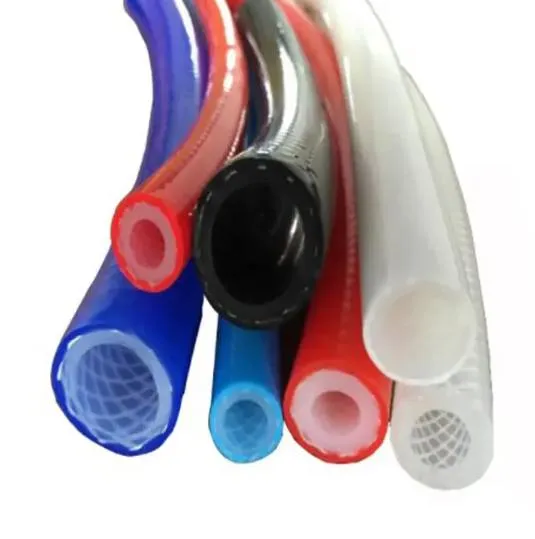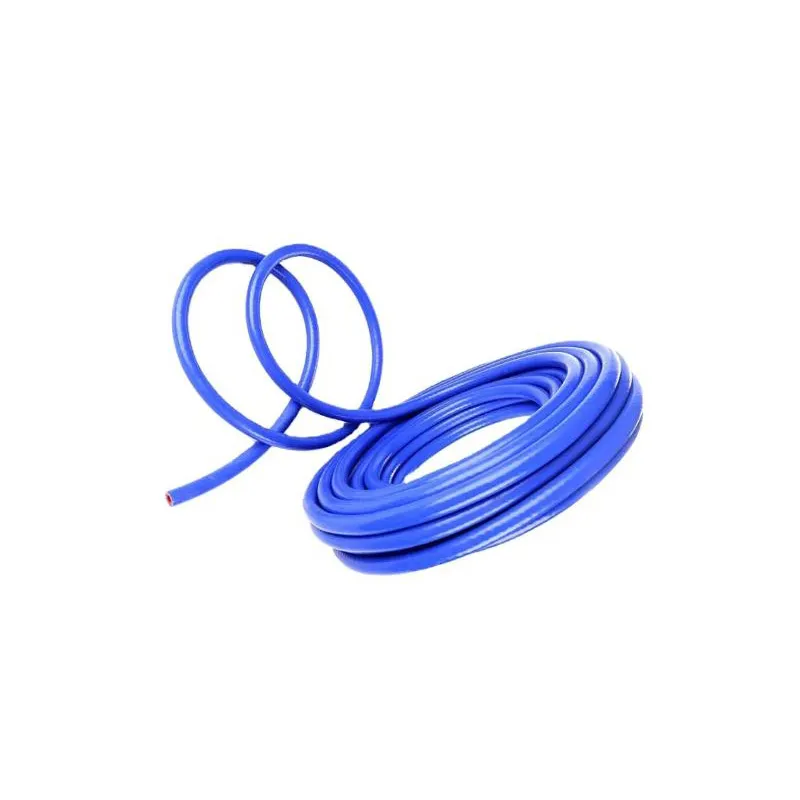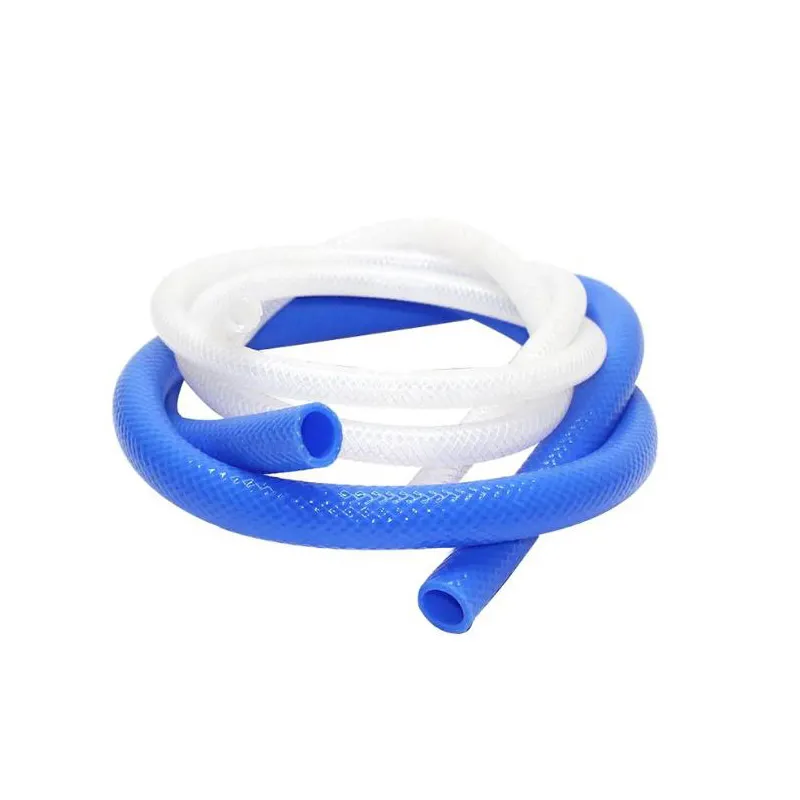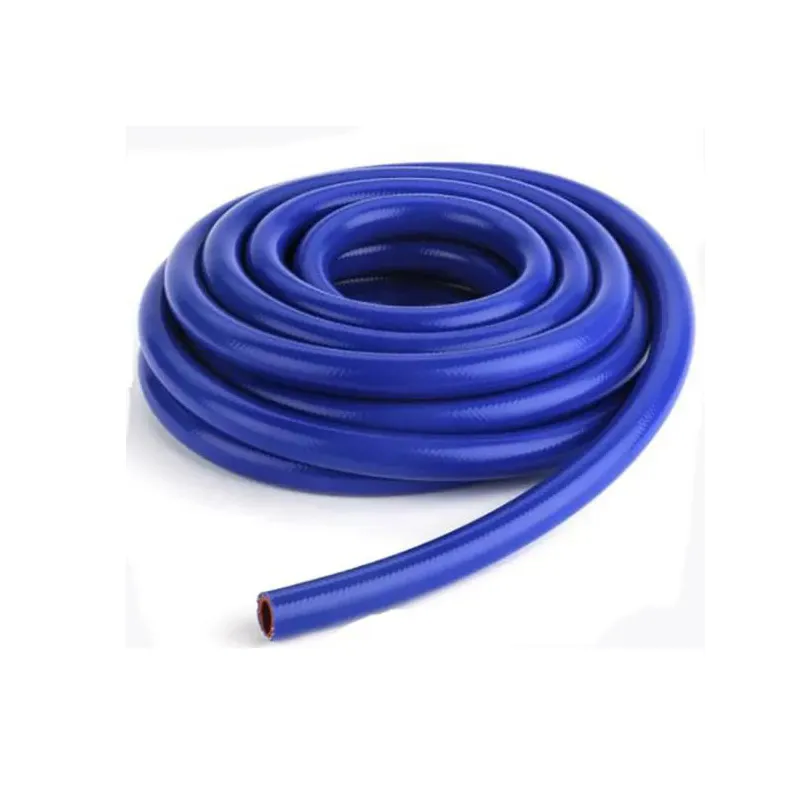Introduction to Advanced Reinforced Silicone Tubing Solutions
In demanding industrial environments, the integrity and performance of fluid transfer systems are paramount. At the forefront of this critical infrastructure are advanced hosing solutions, among which reinforced silicone tubing stands out. This highly engineered component is indispensable across a multitude of sectors, offering superior durability, thermal stability, and chemical resistance compared to conventional rubber or plastic hoses. This comprehensive overview delves into the technical intricacies, application diversity, and strategic advantages of these specialized tubing solutions, providing B2B decision-makers and technical engineers with essential insights for optimal system design and operational efficiency.
Understanding the nuanced properties and manufacturing precision behind solutions like reinforced silicone tubing is crucial for ensuring system reliability, reducing maintenance overheads, and complying with stringent industry standards. From high-temperature fluid conveyance to critical medical applications, the unique characteristics of silicone, coupled with strategic reinforcement, deliver performance benchmarks that are often unattainable with alternative materials.
Current Industry Trends and Market Demands
The market for reinforced silicone tubing is experiencing dynamic growth, driven by several key industry trends. There’s an escalating demand for materials capable of withstanding extreme temperatures and aggressive chemicals, particularly in the automotive, aerospace, and pharmaceutical sectors. The push towards electric vehicles (EVs) has spurred innovation in cooling and battery thermal management systems, where lightweight, durable, and thermally stable hoses are critical. Furthermore, sustainability concerns are leading to increased adoption of long-life components, reducing waste and replacement cycles.
Another significant trend is the increasing need for customization. Standard off-the-shelf solutions often fall short of meeting the precise requirements of highly specialized applications. Manufacturers are now offering extensive customization options, including specific diameters, wall thicknesses, reinforcement types, and custom end-fittings, to meet bespoke operational parameters. The medical and biotech industries are also driving demand for USP Class VI compliant silicone hoses, emphasizing biocompatibility and sterility for critical fluid transfer in sensitive applications. This evolution underscores the versatility and indispensable nature of high-performance silicone reinforced hose in modern industrial landscapes.
Detailed Manufacturing Process Flow of Reinforced Silicone Tubing
The production of high-quality braided silicone tubing is a sophisticated multi-stage process, meticulously controlled to ensure superior performance and longevity. This process integrates advanced material science with precision engineering to create a product capable of enduring demanding operational conditions.
Materials and Preparation:
- Silicone Compound: High-grade silicone gum is blended with platinum catalysts, reinforcing fillers (e.g., fumed silica), pigments, and other additives to achieve specific mechanical and chemical properties, such as Shore A hardness, tensile strength, and color.
- Reinforcement Material: Typically high-strength polyester or aramid fibers (e.g., Nomex, Kevlar) are chosen for their excellent tensile strength and thermal resistance. These fibers are prepared for braiding or wrapping.
Manufacturing Stages:
- Inner Liner Extrusion: The silicone compound is fed into an extruder, where it is heated and forced through a die to form the seamless inner tube (liner). This liner dictates the internal diameter and ensures chemical compatibility with conveyed fluids.
- Reinforcement Application (Braiding/Wrapping):
- Braiding: The extruded inner liner passes through a braiding machine, where multiple strands of reinforcement fibers are interlaced around the tube at a precise angle, typically 45-60 degrees. This creates a robust, uniform layer capable of withstanding significant internal pressure. Multiple layers of braid can be applied for higher pressure ratings.
- Wrapping: For specific applications or larger diameters, fabric plies can be spirally wrapped around the inner liner, sometimes interspersed with thin silicone layers.
- Outer Layer Extrusion: Another layer of silicone compound is extruded over the reinforced core, creating a protective outer jacket. This layer provides abrasion resistance, UV protection, and additional structural integrity.
- Curing (Vulcanization): The constructed hose is then subjected to heat and pressure in an oven or autoclave. This vulcanization process cross-links the silicone polymer chains, transforming the material from a plastic-like state into a highly elastic and durable rubber, locking in its final shape and properties.
- Post-Curing: For high-purity applications, especially in medical or food-grade contexts, an additional post-curing step at elevated temperatures is performed. This removes volatile organic compounds (VOCs) and ensures compliance with strict regulatory standards like FDA or USP Class VI.
- Cutting and Finishing: The continuous hose is cut to specified lengths, and ends may be finished or fitted with connectors as per customer requirements.
Testing Standards and Quality Control:
Throughout the manufacturing process, rigorous quality control measures are implemented. Finished products undergo comprehensive testing to ensure adherence to international standards such as ISO 9001 (Quality Management), ASTM D2000 (Standard Classification System for Rubber Products in Automotive Applications), SAE J20 (Hoses, Standard for Coolant System), and FDA (Food and Drug Administration) regulations for food-contact materials. Key tests include burst pressure testing, vacuum resistance, temperature cycling, compression set, tensile strength, elongation at break, and dimensional stability.
Target Industries and Advantages:
Reinforced silicone tubing offers a typical service life exceeding 10 years under normal operating conditions, significantly outperforming unreinforced alternatives. Its inherent properties translate into distinct advantages in various target industries:
- Petrochemical: Excellent chemical resistance to a wide range of oils, fuels, and solvents, reducing corrosion and ensuring safe transfer.
- Metallurgy: High-temperature stability (up to 250°C/482°F) for coolant lines in harsh environments, ensuring operational continuity and energy saving through reduced heat loss.
- Automotive & Aerospace: Durability against vibration, ozone, and UV, critical for engine coolant, turbocharger, and air intake systems, enhancing component lifespan and reliability.
- Food & Beverage / Pharmaceutical: Non-toxic, odorless, tasteless, and easy to sterilize, meeting stringent FDA/USP Class VI requirements for sanitary fluid transfer, ensuring product purity and safety.
- Water Supply & Drainage: Resistance to environmental degradation and maintaining flexibility in varying temperatures, ideal for pump connections and flexible joints.
The meticulous process and material selection ensure that reinforced silicone tubing delivers unmatched performance, longevity, and safety across these critical applications.

Fig 1: Illustrative manufacturing stage for reinforced silicone tubing.
Technical Specifications and Performance Parameters
The superior performance of reinforced silicone tubing is quantified through a range of critical technical specifications and parameters. These metrics are vital for engineers to select the appropriate hose for their specific application, ensuring both operational efficiency and safety.
Key structural aspects include the inner liner, the reinforcement layer, and the outer cover. The inner liner, typically made of high-purity silicone, ensures smooth fluid flow and chemical compatibility. The reinforcement, often a polyester or aramid fiber braid, is crucial for pressure resistance, while the outer cover protects against environmental factors like abrasion, ozone, and UV radiation.
Critical Performance Parameters:
- Temperature Range: Standard silicone tubing typically operates from -60°C to +200°C (-76°F to +392°F). High-performance variants can extend this to +250°C (+482°F) or even higher for short excursions.
- Working Pressure & Burst Pressure: The reinforcement layer dictates the working pressure (W.P.) and burst pressure (B.P.). W.P. is the maximum continuous pressure the hose can safely handle, typically 1/3 to 1/4 of B.P. Burst pressure is the pressure at which the hose will catastrophically fail. For braided silicone tubing, working pressures can range from 0.5 MPa (70 PSI) for single-braid to over 2.0 MPa (290 PSI) for multi-layer reinforced designs.
- Hardness (Shore A): A measure of the material’s resistance to indentation, typically ranging from 50 to 80 Shore A for silicone hoses. A higher Shore A indicates a stiffer material.
- Tensile Strength: The maximum stress the material can withstand before breaking, usually expressed in MPa (MegaPascals) or PSI. High tensile strength contributes to durability.
- Elongation at Break: The percentage increase in length before failure, indicating the material’s elasticity and flexibility. Silicone typically offers high elongation.
- Minimum Bend Radius: The smallest radius to which a hose can be bent without kinking, reducing its service life, or impairing performance. Critical for installation in confined spaces.
- Vacuum Rating: The ability of the hose to withstand negative pressure without collapsing, crucial for suction applications.
- Chemical Compatibility: Resistance to acids, bases, solvents, and oils. Silicone is generally inert but specific compounds are formulated for enhanced resistance to particular chemicals.
Typical Product Specification Table:
| Parameter | Typical Range for Reinforced Silicone Tubing | Unit |
|---|---|---|
| Inner Diameter (ID) | 6 – 150 | mm |
| Outer Diameter (OD) | 12 – 165 | mm |
| Wall Thickness | 3 – 7.5 | mm |
| Working Pressure (W.P.) | 0.5 – 2.5 (up to 4.0 for specialized) | MPa |
| Burst Pressure (B.P.) | 1.5 – 7.5 (up to 12.0 for specialized) | MPa |
| Temperature Range | -60 to +200 (-76 to +392) | °C (°F) |
| Hardness (Shore A) | 60 ± 5 | – |
| Tensile Strength | 8.0 – 12.0 | MPa |
| Elongation at Break | 300 – 500 | % |

Fig 2: Example of a braided silicone tubing under stress testing.
Application Scenarios and Exemplary Case Studies
The robust characteristics of reinforced silicone tubing make it a preferred choice for critical applications across diverse industries. Its reliability under extreme conditions and chemical inertness are key differentiators.
Automotive & Heavy Duty Vehicles:
- Engine Coolant Systems: Used for radiator hoses, heater hoses, and turbocharger connections. They withstand high temperatures, fluctuating pressures, and resist coolant chemicals, preventing cracks and leaks that are common with traditional rubber hoses. Their flexibility also simplifies installation in tight engine compartments.
- Air Intake Systems: Provides flexible connections for air filters, intercoolers, and turbochargers, where extreme temperatures and pulsations are common.
- Case Study: High-Performance Racing Engines. A leading motorsports team replaced conventional EPDM hoses with multi-ply silicone reinforced hose for their turbocharged engine cooling system. The switch resulted in a 15% reduction in hose failures during endurance races, attributable to silicone’s superior heat resistance (up to 250°C) and resistance to thermal cycling fatigue, leading to increased reliability and less unscheduled downtime.
Pharmaceutical & Biopharmaceutical:
- Peristaltic Pump Tubing: The excellent flex-fatigue resistance and resilience of platinum-cured silicone make it ideal for peristaltic pump applications, maintaining consistent flow rates over extended periods without spallation.
- Sterile Fluid Transfer: For conveying high-purity media, culture solutions, and reagents, particularly in single-use systems. Compliance with USP Class VI, FDA, and ISO 10993 ensures non-toxicity and biocompatibility.
- Case Study: Vaccine Production Line. A major pharmaceutical manufacturer integrated braided silicone tubing into their sterile filling lines for vaccine production. The hoses provided certified non-leaching properties, withstood repeated autoclave sterilization cycles at 121°C, and ensured zero contamination risks, contributing to the consistent quality and safety of their critical product.
Food & Beverage Processing:
- Dairy & Beverage Transfer: Used for conveying milk, juices, beer, and other food-grade liquids. Silicone’s inertness prevents taste contamination, and its smooth bore prevents bacterial buildup, making it easy to clean-in-place (CIP) and sterilize-in-place (SIP).
- High-Temperature Cooking Oils/Steam: Robust enough to handle hot oils and steam, crucial in industrial cooking and sterilization processes.
- Case Study: Craft Brewery CIP System. A craft brewery adopted FDA-compliant reinforced silicone tubing for their CIP systems, replacing PVC hoses. The new silicone hoses resisted caustic cleaning agents, handled hot water (80°C) without degradation, and significantly extended the lifespan of their transfer lines, reducing operational downtime for hose replacement by 30%.
Other Industrial Applications:
- Chemical Transfer: For a select range of chemicals, tailored silicone compounds offer chemical resistance where other elastomers fail.
- Medical Devices: In respiration equipment, dialysis machines, and surgical suction, where biocompatibility and precise fluid control are essential.
- Renewable Energy (Solar/Wind): Used in cooling systems for inverters and other electronic components due to their resilience to outdoor elements and thermal cycling.

Fig 3: Reinforced silicone tubing integrated into industrial machinery.
Technical Advantages and Performance Edge
The widespread adoption of reinforced silicone tubing is predicated on its distinct technical advantages, which translate into superior performance and long-term cost savings compared to traditional hose materials.
- Exceptional Thermal Stability: Silicone maintains its physical properties across an extraordinarily broad temperature range, typically from -60°C to +200°C (-76°F to +392°F), with special grades reaching higher. This makes it ideal for both extreme cold and hot environments, where other elastomers would become brittle or degrade rapidly.
- Superior Chemical Resistance: While not universally chemical-proof, silicone offers excellent resistance to ozone, UV radiation, oxygen, moisture, and many common chemicals including acids, bases, and automotive coolants. This inertness prevents degradation, hardening, or softening, extending service life significantly.
- Enhanced Pressure Resistance: The integral reinforcement layer, typically a polyester or aramid fiber braid, provides the structural integrity necessary to withstand high internal pressures, far exceeding what unreinforced silicone tubing can manage. This allows for safe and efficient fluid transfer in pressurized systems.
- Flexibility and Durability: Despite reinforcement, silicone hoses retain significant flexibility, easing installation and reducing strain on connection points. They exhibit excellent resistance to flex-fatigue, vibration, and kinking, contributing to a longer service life and reduced maintenance.
- Biocompatibility and Non-Toxicity: Platinum-cured silicone is renowned for its ultra-purity, making it non-toxic, odorless, and tasteless. This makes it indispensable for medical, pharmaceutical, and food & beverage applications where product purity and patient safety are paramount, often meeting USP Class VI and FDA compliance.
- Electrical Insulation Properties: Silicone is an excellent electrical insulator, a beneficial characteristic in sensitive electronic cooling systems or applications where stray electrical currents are a concern.
- Reduced Permeability: Silicone generally exhibits lower gas permeability compared to many other elastomers, which can be critical for maintaining vacuum integrity or preventing gas ingress/egress in certain applications.
These combined advantages position silicone reinforced hose as a cost-effective solution in the long run, minimizing system failures, reducing replacement frequency, and ensuring operational continuity in critical industrial processes.
Vendor Comparison and Selection Criteria
Choosing the right supplier for reinforced silicone tubing is as critical as selecting the product itself. A comprehensive vendor evaluation ensures not only product quality but also reliable supply, technical support, and competitive total cost of ownership.
Key Vendor Selection Criteria:
- Certifications and Compliance: Verify ISO 9001 for quality management, and product-specific certifications like FDA, USP Class VI, SAE J20, or specific military/aerospace standards relevant to your industry. This indicates adherence to rigorous quality and safety protocols.
- Material Expertise: Assess the vendor’s deep knowledge of silicone chemistry and reinforcement materials. Can they recommend specific silicone grades (e.g., general-purpose, high-tear strength, low compression set, extreme temperature) and reinforcement types (e.g., polyester, aramid) for your application?
- Customization Capabilities: Look for vendors who offer tailored solutions—custom IDs, ODs, wall thicknesses, lengths, colors, multi-ply reinforcement, specialized fittings, and branding.
- Testing and Quality Assurance: Inquire about their in-house testing facilities and protocols (burst pressure, tensile strength, hardness, thermal cycling). A robust QA process is vital.
- Technical Support and Engineering Assistance: A good vendor provides pre-sales consultation and post-sales support, helping with design optimization, problem-solving, and material compatibility issues.
- Lead Time and Fulfillment: Evaluate their production capacity, inventory management, and ability to meet your delivery schedules, especially for custom orders or large volumes.
- Reputation and Experience: Longevity in the industry, positive customer testimonials, and partnerships with reputable clients (anonymized if necessary) are strong indicators of reliability and authority.
Product Comparison Table (Example – comparing different hose types):
| Feature | Reinforced Silicone Tubing | EPDM Rubber Hose | PVC Reinforced Hose |
|---|---|---|---|
| Temperature Range | -60°C to +200°C | -40°C to +120°C | -10°C to +60°C |
| Ozone/UV Resistance | Excellent | Good | Poor |
| Chemical Resistance | Very Good (specific) | Good (polar substances) | Fair (general purpose) |
| Flexibility | High | Moderate | Moderate to Stiff |
| Pressure Rating | High (reinforced) | Moderate (reinforced) | Low to Moderate |
| Biocompatibility | Excellent (USP Class VI) | Poor | Poor |
| Cost (Relative) | Higher | Moderate | Lower |

Fig 4: Quality control inspection of reinforced silicone tubing.
Customized Solutions for Specialized Requirements
While standard reinforced silicone tubing offers broad utility, many B2B applications demand highly specific, tailor-made solutions. Leading manufacturers understand this necessity and provide extensive customization options to precisely match unique operational parameters and system integrations.
Key Areas of Customization:
- Dimensions (ID, OD, Wall Thickness): Exact inner and outer diameters, along with precise wall thickness, can be engineered to optimize flow rates, pressure ratings, and fitment with existing connectors.
- Material Compounds: Silicone formulations can be modified for enhanced properties, such as increased tear strength, improved compression set, extended high or low-temperature resistance, greater chemical compatibility (e.g., fluorosilicone for fuel/oil resistance), or enhanced electrical conductivity/insulation.
- Reinforcement Layers: The number of reinforcement plies (single, double, triple braid), type of fiber (polyester, aramid), and braiding angle can be adjusted to achieve specific burst and working pressure ratings, as well as desired flexibility.
- Color and Branding: Custom colors for visual identification or aesthetic integration, along with private labeling or embossed branding, can be incorporated.
- Form and Geometry: Beyond straight lengths, custom shapes such as complex bends, reducers, elbows, and branched configurations (e.g., Y-pieces, T-pieces) can be manufactured to streamline fluid paths and eliminate multiple connection points.
- End Finishes and Fittings: Integration of specialized cuffs, beads, flanges, or pre-assembled metal fittings (e.g., quick-connects, clamps) directly onto the hose reduces installation time and improves seal integrity.
- Surface Treatments: Internal or external surface treatments can be applied to achieve specific properties, such as reduced friction for easier insertion or enhanced non-stick characteristics.
- Regulatory Compliance: Tailored solutions can be specifically designed and tested to meet stringent industry standards such as FDA, USP Class VI, ISO 10993, SAE J20, or specific medical device directives.
Collaborating with a manufacturer offering robust customization allows businesses to optimize system performance, minimize compatibility issues, and extend the lifespan of their critical fluid transfer components, leveraging the full potential of silicone reinforced hose.

Fig 5: Example of a custom-shaped reinforced silicone tubing assembly.
Frequently Asked Questions (FAQ)
- Q1: What are the primary advantages of reinforced silicone tubing over EPDM rubber hoses?
- A1: Reinforced silicone tubing offers a significantly wider operating temperature range, superior resistance to ozone and UV degradation, and generally better long-term flexibility retention. While EPDM is good for water and steam, silicone excels in high-heat applications and offers enhanced chemical inertness for specific media. Silicone also has better compression set resistance and often a longer service life.
- Q2: Is reinforced silicone tubing suitable for fuel or oil transfer?
- A2: Standard silicone has limited resistance to petroleum-based fuels and oils. However, specialized fluorosilicone (FVMQ) reinforced tubing is engineered for excellent resistance to fuels, oils, and harsh chemicals, making it suitable for such applications where conventional silicone would swell or degrade. Always consult with the manufacturer for specific chemical compatibility data.
- Q3: How long can I expect reinforced silicone tubing to last?
- A3: The service life of braided silicone tubing varies based on application, operating conditions (temperature, pressure, chemical exposure), and proper installation. Under ideal conditions, high-quality reinforced silicone hoses can last 10-20 years. In demanding automotive or industrial settings, a lifespan of 5-10 years is typical, significantly outperforming many traditional elastomers. Regular inspection is recommended to ensure optimal performance.
- Q4: What are the typical lead times for custom reinforced silicone tubing orders?
- A4: Lead times for custom orders of reinforced silicone tubing can vary depending on complexity, material availability, and order volume. For standard custom dimensions, lead times might range from 3-5 weeks after design approval. Highly specialized designs requiring unique tooling or specific material formulations may extend to 8-12 weeks. We recommend contacting our sales team with your specific requirements for a precise quote and delivery schedule.
- Q5: What warranty and after-sales support do you offer for your silicone hoses?
- A5: We provide a comprehensive warranty against manufacturing defects for all our silicone reinforced hose products, typically covering 12-24 months from the date of purchase. Our dedicated after-sales support team offers technical assistance, troubleshooting, and advice on product maintenance and optimization. We also provide documentation for material certifications and compliance, ensuring complete customer satisfaction.
Conclusion: The Indispensable Role of Reinforced Silicone Tubing
In summary, reinforced silicone tubing represents a pinnacle of fluid transfer technology, offering an unparalleled combination of thermal stability, chemical inertness, pressure resistance, and longevity. Its versatility and adaptability, particularly through custom engineering, make it an indispensable component across high-stakes industries from automotive and aerospace to pharmaceutical and food processing. By understanding its manufacturing intricacies, technical specifications, and diverse application benefits, B2B decision-makers and engineers can confidently integrate these advanced hoses to enhance operational reliability, ensure compliance, and achieve significant long-term value. The continuous innovation in material science and manufacturing processes further solidifies its position as a critical element in modern industrial infrastructure.
References
- ASTM International. “D2000 – Standard Classification System for Rubber Products in Automotive Applications.”
- SAE International. “SAE J20 – Standard for Coolant System Hoses.”
- U.S. Food and Drug Administration. “Code of Federal Regulations, Title 21, Part 177.2600 (Rubber Articles Intended for Repeated Use).”
- United States Pharmacopeia. “USP Class VI Biological Reactivity Tests, In Vivo.”
- ISO (International Organization for Standardization). “ISO 9001 – Quality management systems – Requirements.”
HEBEI ZHOUCONG IMP AND EXP CO.,LTD. Z-Smartflex, first opend in 2017Industrial Hose china .Located in Shijiazhuang,Hebei, the company has been eminently successful in developing and marketing a complete line of industrial hose,plastic hose, hydraulic hose and fittings. hydraulic hose manufacturers Today, Hebei Zhoucong Imp & Exp Trade Co.,Ltd, group of companies includes two subsidiaries and five distribution centers, as well as many agents, providing a complete line of thermoplastic, rubber oil hose factory rubber and plastic hose products and accessories including couplings and fittings, for use in industrial ,agriculture,rubber water hose manufacturers and garden applications.rubber air hose manufacturers